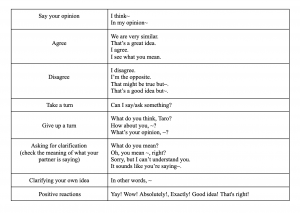Interactional Competence – Three Classroom Activities
Most EFL teachers are probably familiar with the stilted nature of the learner to learner conversational interaction. Low confidence, lack of vocabulary or grammar to express ideas, or anxiety about the quality of ideas, are some factors that may come into play for beginners. For the teacher, traditional ways to combat these roadblocks might be to use controlled substitution drill activities, provide models and sample conversations for students to make use of when devising their own conversations or to simply provide extra time for idea or language preparation. Whilst helpful for many students, I wonder if these ideas would benefit the intermediate learner who has a strong goal to become proficient in English and to use it naturally and freely without scaffolding. Indeed, activities such as those presented by Mabrouk (2017) and Wilson (2020), in past editions of EFL Magazine, require a command of English that controlled activities just do not prepare learners for. Therefore, for learners in the intermediate stage, building interactional competence may be the key.
Background on interactional competence
Most TEFL professionals have come across communicative competence as a goal for any L2 learner. Building on the ideas of Hymes, (1966, in Brown, 2000) Canale and Swain (1980, in Brown, 2000) it is believed to comprise four competencies: linguistic, discourse, sociolinguistic, and strategic. Linguistic competence refers to what Chomsky intimates as the appropriate use of linguistic features such as grammar and vocabulary. Discourse competence is the ability to string words together to communicate ideas. Sociolinguistic competence is the awareness of setting, relationships, and cultural background of participants. Strategic competency is the ability to deal with communication breakdown. More recently, researchers have expanded on these ideas and included interactional competence, or what Waring calls ‘the actual use of language’ as another aim for the L2 learner (2018, p.57). This idea emphasises the interplay between multiple interlocutors and ‘the practices of turn-taking, sequencing, overall structuring and repair’ (supra, p. 59).
The following activities were designed to help upper-intermediate English learners (average TOEIC 550) to notice and to deliberately practice sequencing and turn-taking:
-
Activity 1: Slow Class Discussion

In this activity, the teacher facilitates a class discussion in which the flow of discourse is closely moderated and learners are asked to listen and to respond to each other before expressing their own opinion. The stop-start nature of the activity brings metacognitive awareness of turn-taking phrases and pragmatic conventions (Dörnyei, 2009). The pace of the task allows all learners, regardless of proficiency with the L2, to have a moment to reflect on their classmates’ ideas, and to then formulate and express their own ideas. This brings focus to the importance of listening and of engaging with others’ views. The teacher also models language to use when turning over the ‘floor’ (to another speaker), for example “What do you think, Yumi? In what situation would Kenta’s idea apply, Kana?”. This aspect of the activity pinpoints key phrases to use to control the flow of the discussion. Having a phrase bank (Appendix) to draw from, feasibly gives learners the confidence to participate proactively in a group discussion task.
-
Activity 2: Stop Game

Similar to “Slow Class Discussion”, this activity also provides support for the learner who may need an extra bit of time to compose their thoughts or language. Prior to holding small group discussions, each learner is given a card with the image of a stop sign on it. During the discussion, the learners use it to stop the flow of discussion when necessary. The learner who uses the stop sign is responsible for collecting their thoughts and expressing them, thereby restarting the discussion. During the pause, all group members will have an opportunity to use dictionaries to look up words, or simply plan what to say. In addition, learners can write useful phrases, like those in the phrase bank (Appendix), or those they want to practice, on a sticky note to paste to the rear of the card, thus, facilitating deliberate practice of phrases.
-
Activity 3: Agree Tennis

This activity requires learners to build on the utterances of their partner. Learners break into pairs and are asked to agree on a teacher-devised topic. Topics should be easy (for example: ‘Starbucks is the best coffee shop’.) as the main goal of this activity is to promote awareness of, and practice in, building a dialogue with another person. The teacher sets a timer (2-4 minutes depending on the proficiency of the class as a whole) and students trade reasons (for example: ‘It has free Wi-Fi…The Frappuccino’s’ are delicious.’) in a rally style as if they are playing tennis. An alternative is to ask students to trade examples (such as: ‘My favourite Frappuccino is the green tea one…I like the sesame flavoured one they just introduced in December). Pairs compete with each other to see which team can come up with the most reasons or examples in the time allotted. Several rounds could be played to increase practice opportunities. The activity provides a healthy dose of fun and competition, whilst also allowing learners to practice the skill of building on each other’s ideas.
Conclusion
Helping learners in their quest to converse naturally with peers is not an easy task. However, teachers who identify pivotal moments and offer opportunities for learners to practice, provide much needed scaffolding for many learners. The activities described in this article are just a few ideas to orient language educators in helping students to break away from scripted or memorised conversation, towards natural spoken discourse. What activities do you use in your classroom to introduce or practice interactional competence?
References
- Brown, J. D. (2000). Principles of language learning and teaching. (4th Ed.) Longman.
- Dörnyei, Z. (2009). Communicative language teaching in the 21st century: The ‘principled communicative approach’ 36(2), Perspectives, 33-43. https://www.academia.edu/2695369/Communicative_Language_Teaching_in_the_21st_Century_the_Principled_Communicative_Approach_
- Mabrouk, M. H. (2017, July 14). Socratic circles in the EFL classroom. EFL Magazine. https://www.eflmagazine.com/socratic-circles-efl-classroom/
- Waring, H. Z. (2018). Teaching L2 interactional competence: Problems and possibilities. Classroom Discourse, 9(1), 57-67. https://doi.org/10.1080/19463014.2018.1434082
- Wilson, D. (2020, October 3). Using negotiation role plays in the English classroom. EFL Magazine. https://www.eflmagazine.com/using-negotiation-role-plays-in-the-english-classroom/
Appendix
Discussion phrase bank





